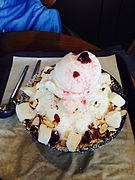Bingsu
 Pat-bingsu (red bean bingsu) | |
| Alternative names | Bingsoo |
|---|---|
| Type | Shaved ice |
| Course | Dessert |
| Place of origin | South Korea |
| Serving temperature | Cold |
| Main ingredients | Ice, toppings |
| Variations | Pat-bingsu (red bean bingsu), nokcha-bingsu (green tea bingsu), ttalgi-bingsu (strawberry bingsu), choko-bingsu (chocolate bingsu), etc |
| Korean shaved ice | |
| Hangul | 빙수 |
|---|---|
| Hanja | 氷水 |
| Revised Romanization | bingsu |
| McCune–Reischauer | pingsu |
| IPA | [piŋ.su] |
| Red bean shaved ice | |
| Hangul | 팥빙수 |
| Hanja | 팥氷水 |
| Revised Romanization | pat-bingsu |
| McCune–Reischauer | p'at-pingsu |
| IPA | [pʰat̚.p͈iŋ.su] |
Bingsu (Korean: 빙수), sometimes Anglicized as bingsoo,[1] is a popular Korean shaved ice dessert with sweet toppings that may include chopped fruit, condensed milk, fruit syrup, and red beans.[2][3] The most common variety is pat-bingsu (Korean: 팥빙수), the red bean shaved ice. The main ingredient of ice was natural ice in the past, but later artificial ice was produced and high-quality sweeteners were developed, and now it has been improved into boiled red bean shaved ice or fruit shaved ice mixed with various fruits. At first, the ice-cutting machine was a simple tool in the shape of a plane, but now the electric power is widely used after a manual rotation by hand.
History[]
The oldest origin of bingsu stems from the mixing of honey and fruit juice with snow or ice in China around 3000 B.C. Italy's Marco Polo's "Oriental Book" states that he brought to Venice the recipe for "frozen milk", which he enjoyed eating in Beijing, China.[4] In the West, there is a theory that Alexander the Great of Macedonia made it when he occupied the Persian Empire around 300 B.C., and when soldiers collapsed from heat and fatigue, they ate it with honey and fruit juice in the snow piled up in the high mountains. Caesar, a Roman politician and general, allegedly drank cold milk and ice from the Alps. In Korea, it is recorded that the ice of Seokbingo was distributed to officials during the Joseon Dynasty, and this was broken into small pieces and made into fruit punch.
The early forms of patbingsu consisted of shaved ice and two or three ingredients, typically red bean paste, tteok, and ground nut powder.[5] The earliest forms of patbingsu existed during the Joseon dynasty (1392–1897). Government records show officials sharing crushed ice topped with various fruits.[6][7]
The modern version of the dessert usually is placed in the Korean bakery Tae Keuk Dang. However, elder people in Korea use to point out that the patbingsu became popular after the Korean war. The dish was made with ingredients from the USA surplus supplies and was sold as street food.[8]
Varieties[]
Patbingsu (팥빙수, 팥氷水, sometimes anglicized as patbingsoo, literally "red beans shaved ice") is a popular Korean shaved ice dessert with sweet toppings that may include chopped fruit, condensed milk, fruit syrup, and red beans.[2]
The food originally began as ice shavings with red beans (known as pat, 팥). Many varieties of patbingsu exist in contemporary culture.
There are a variety of bingsu types and flavors. Many bingsu do not necessarily follow tradition, and some do not include the red bean paste.[9] Some popular flavors are: green tea, coffee, and yogurt.[10]
In various countries[]
Korea[]
In addition to the existing patbingsu, several Korean franchises led by Sulbing have made shaved ice made from various ingredients such as Injeolmi shaved ice, melon shaved ice, coffee shaved ice, and green tea shaved ice. Since the Joseon Dynasty, it was the first time to mix honey and fruit with ice taken from bingo, and after the Korean War, condensed milk, syrup and chocolate were introduced to the United States and modern "Korean shaved ice" began to be made.[11]
Japan[]
In a tea shop in Kagoshima, Shirokuma (the white bear, 白熊) was made, and the shape of white condensed milk poured over shaved ice in a round bowl and fruits such as sweet red beans, cherries, and tangerines was named after what looked like a white bear's face.
Taiwan[]
Due to the Taiwanese characteristics of mangoes, mango shaved ice with a lot of mangoes is famous. Monster bingsu[12] is also famous for freezing various flavors of milk, grinding it into layers, and putting chocolate shaped like eyeballs. Taiwan's shaved ice seems to have been ground to show the grain of milk rather than frozen ice with water.
Availability[]
Bingsu can be found at most fast food restaurants, cafes, and bakeries in South Korea.[2] Bingsu is also a very popular dessert at cafes in Koreatowns around the world.[citation needed]
Gallery[]
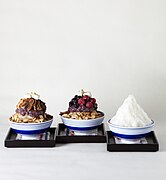
Various bingsu
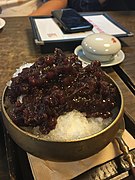
Patbingsu
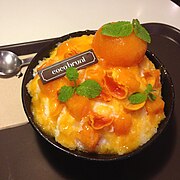
Persimmon bingsu from Coco Bruni patisserie in Hannam-dong, Seoul
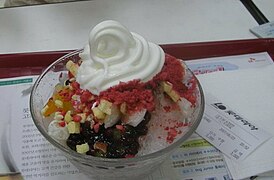
Lotteria offers an elaborate version with ice cream

A yogurt bingsu from the popular Korean Red Mango chain
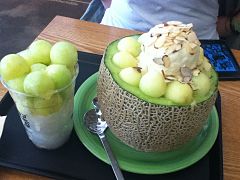
Melon bingsu from Chaoruem near Gangnam station

Patbingsu topped with fruits
Berry bingsu
Milk tea bingsu

Black sesame bingsu
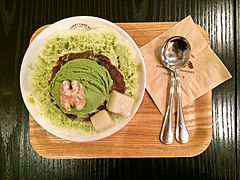
Green tea bingsu
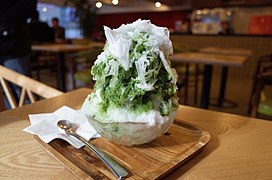
Green tea bingsu
Cheese bingsu
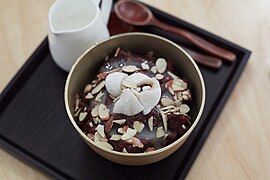
Patbingsu
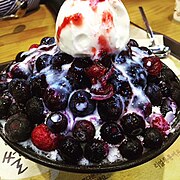
Mixed-berry bingsu
See also[]
- Korean cuisine
- Ais kacang
- Baobing
- Halo-halo
- Kakigori
- Grattachecca
- : a Guadeloupe, Martinique, French Guyana shaved ice
References[]
- ^ Hoo, Winyan Soo (July 16, 2014). "Plate Lab: A guide to Asian shaved ice desserts halo-halo, bao-bing and bingsoo". The Washington Post. ISSN 0190-8286. Retrieved May 5, 2016.
- ^ Jump up to: a b c Lee, Robyn (June 5, 2009). "Snapshots from South Korea: Patbingsu, a Popular Shaved Ice Dessert". Serious Eats. Retrieved January 5, 2013.
- ^ Kyoung Woo Jun, for. "Seoul hotels at war over dessert - CNN.com". CNN. Retrieved May 5, 2016.
- ^ "Ice cream explorations and a peek into the past". koreatimes. June 3, 2010. Retrieved June 11, 2021.
- ^ Min, Ines (June 3, 2010). "Ice cream explorations and a peek into the past". The Korea Times. Retrieved January 5, 2014.
- ^ Dang, Tae Keuk (September 13, 2010). "Snowy delights and variations on bingsu". Herald Corporation. Retrieved January 6, 2014.
- ^ 팥빙수[氷水] [Patbingsu]. Doopedia (in Korean). Doosan Corporation. Retrieved January 6, 2014.
- ^ "Seoul Eats: The Origin of Patbingsu". Seoul Eats. Retrieved August 9, 2020.
- ^ "Bingsu, an unbeatable summer treat!". KOREA TOURISM ORGANIZATION. Retrieved January 6, 2014.
- ^ Lee, Ji-yoon (July 7, 2008). "Korea's cold summer taste - naengmyeon and patbingsu". Korea.net. The Korean Culture and Information Service. Retrieved January 6, 2013.
- ^ Linda (October 12, 2019). "15 of the Best Bingsu in Seoul". Linda Goes East. Retrieved June 11, 2021.
- ^ Ang, Daniel. "Roji Monster Ice Cream – Taiwanese Shaved Ice Cream Shop Opens Till 12AM (Fri & Sat) At Tanjong Pagar – DanielFoodDiary.com". Retrieved June 11, 2021.
External links[]
| Wikimedia Commons has media related to Bingsu. |
- Ice-based desserts
- Korean cuisine
- Winter in culture












